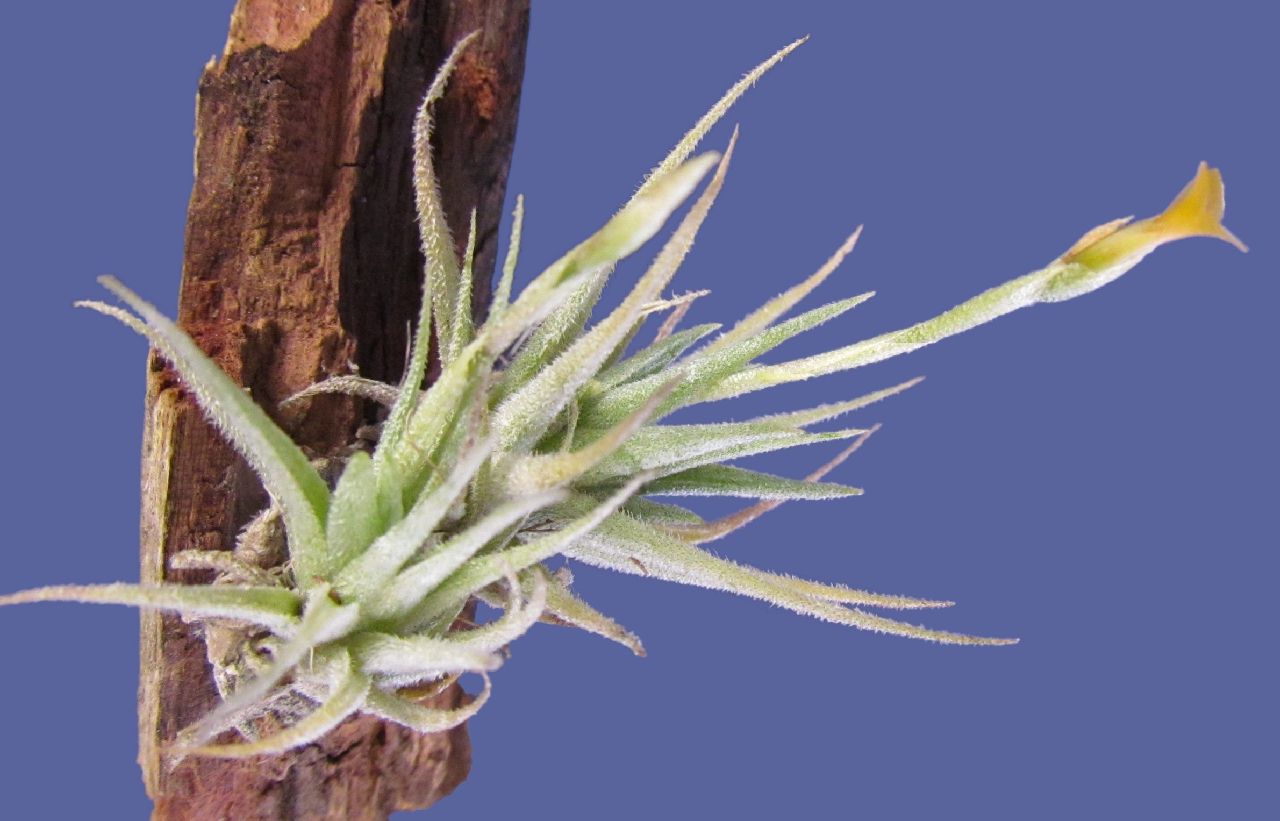
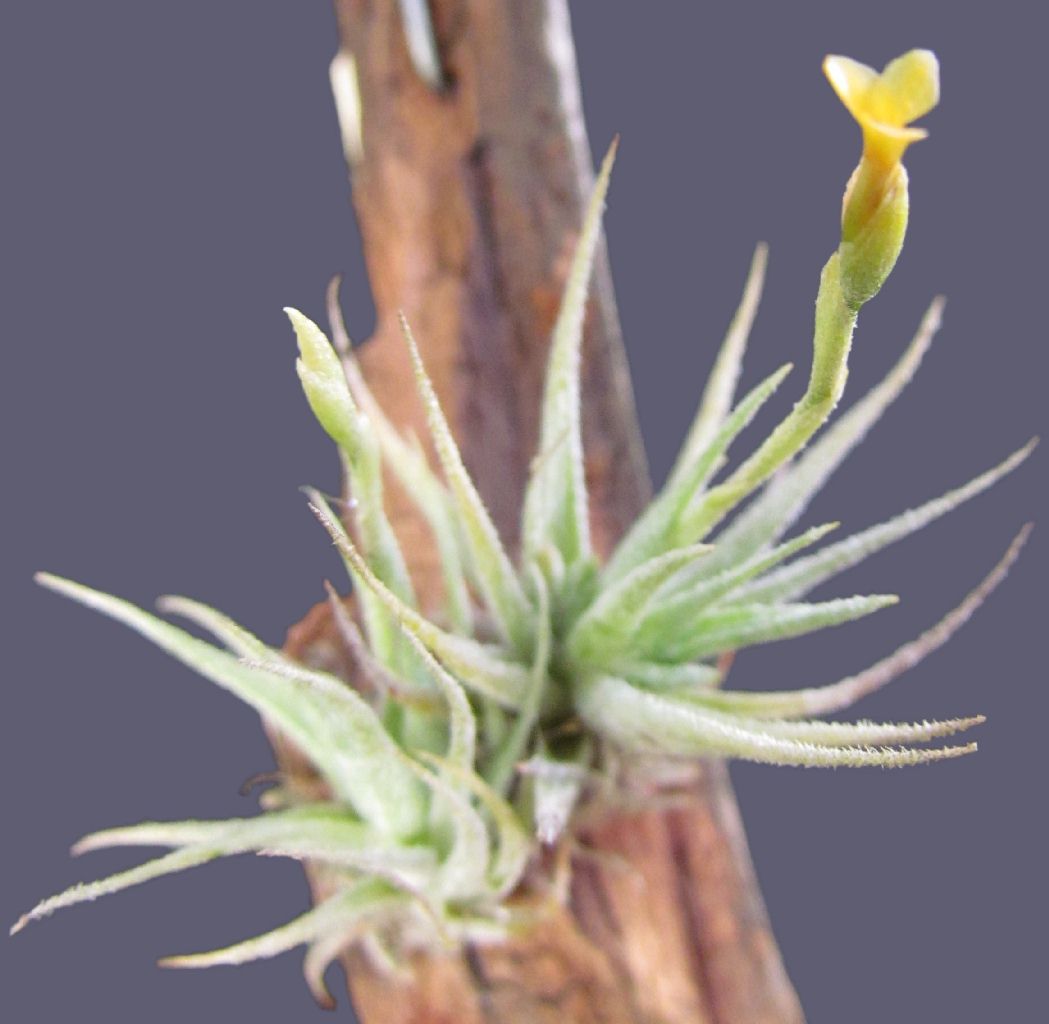
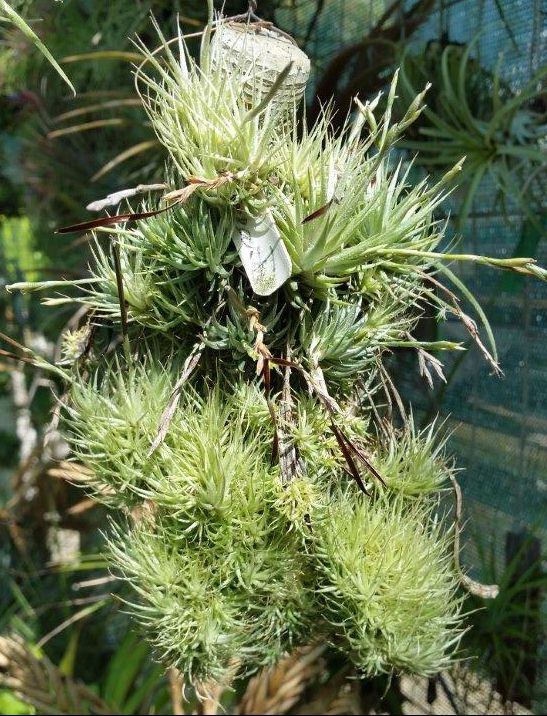
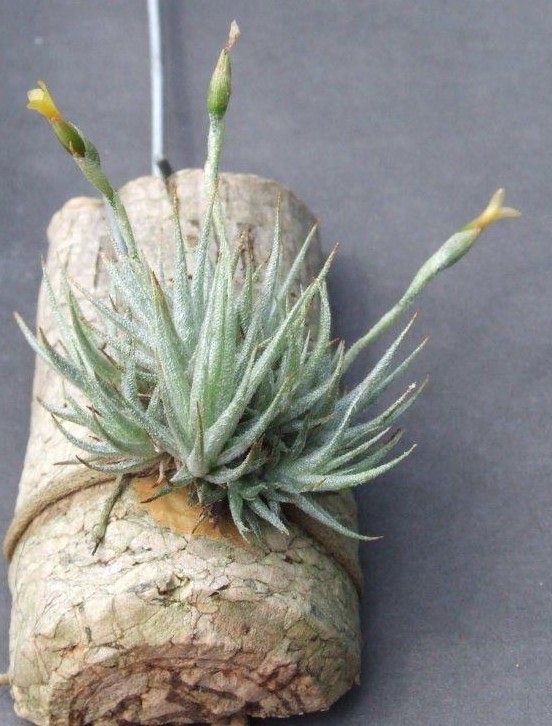
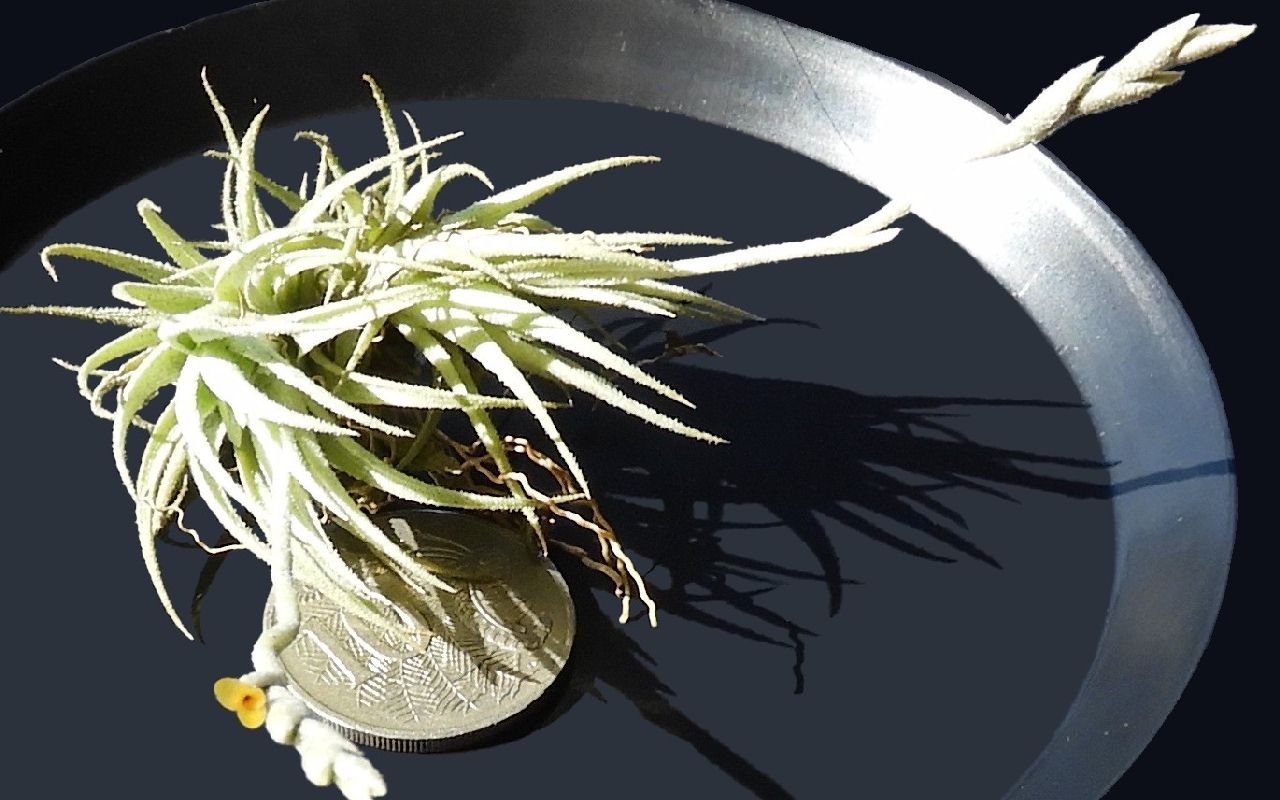
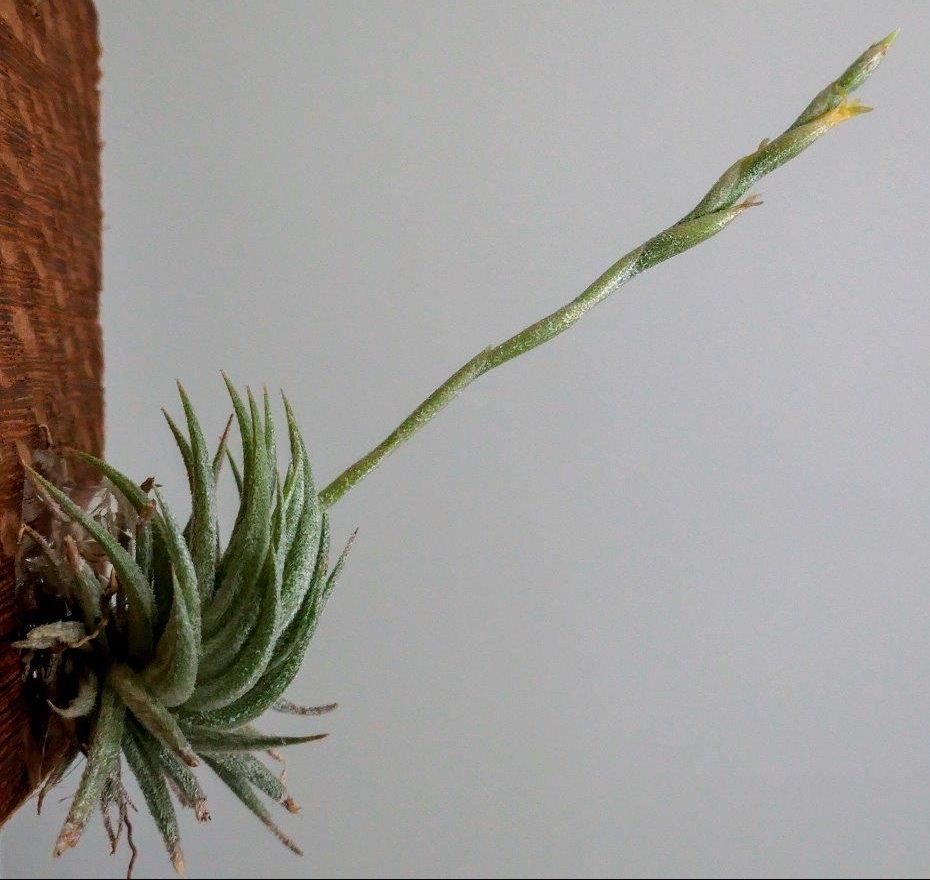
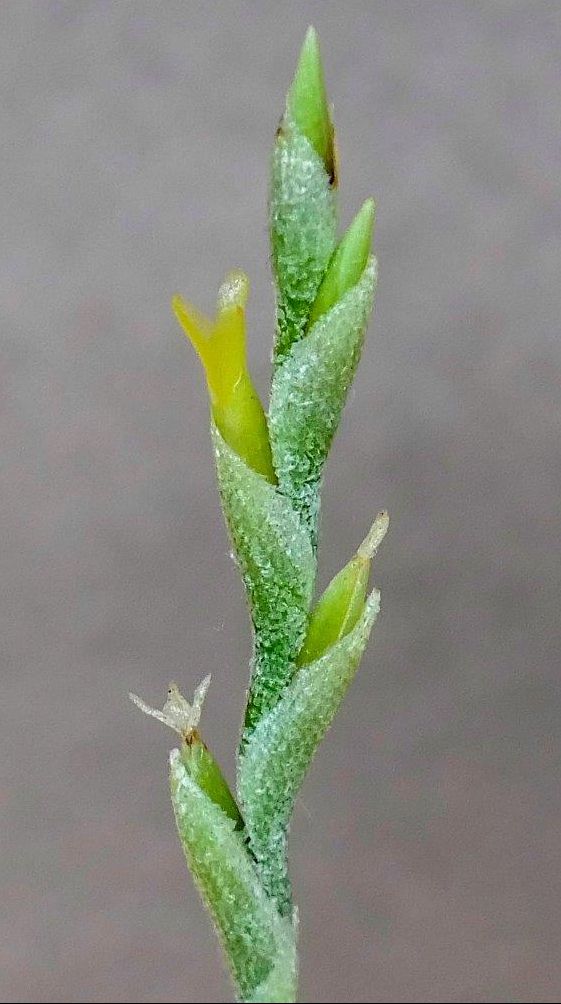
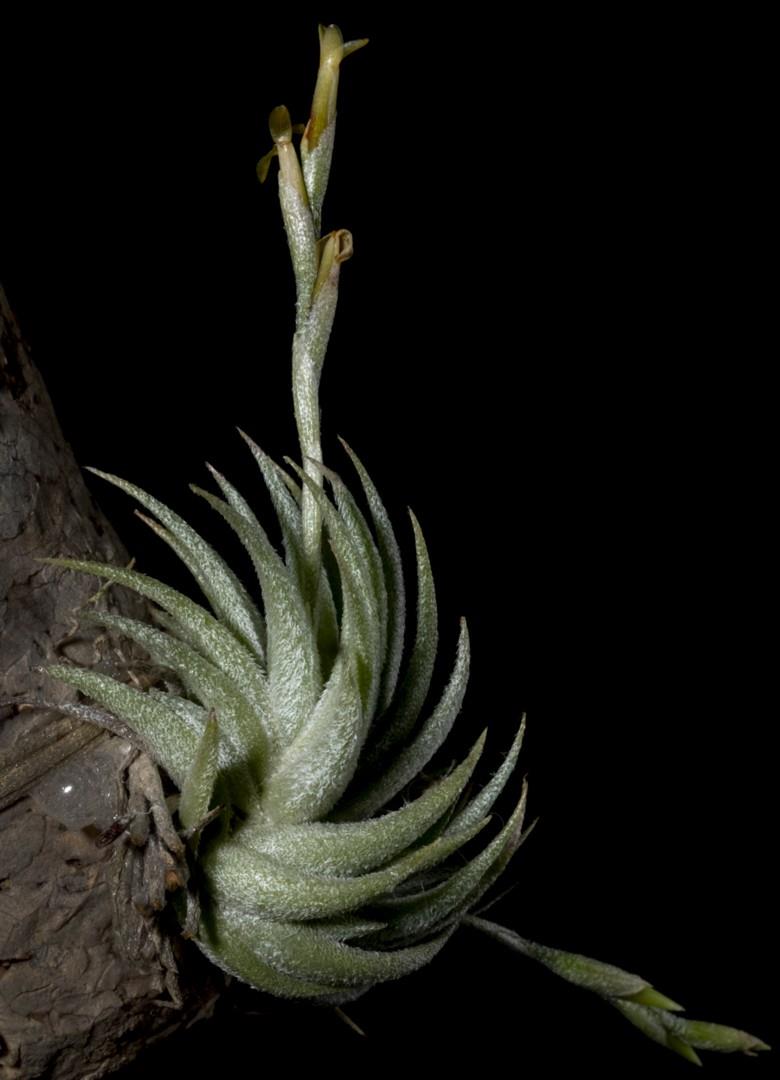
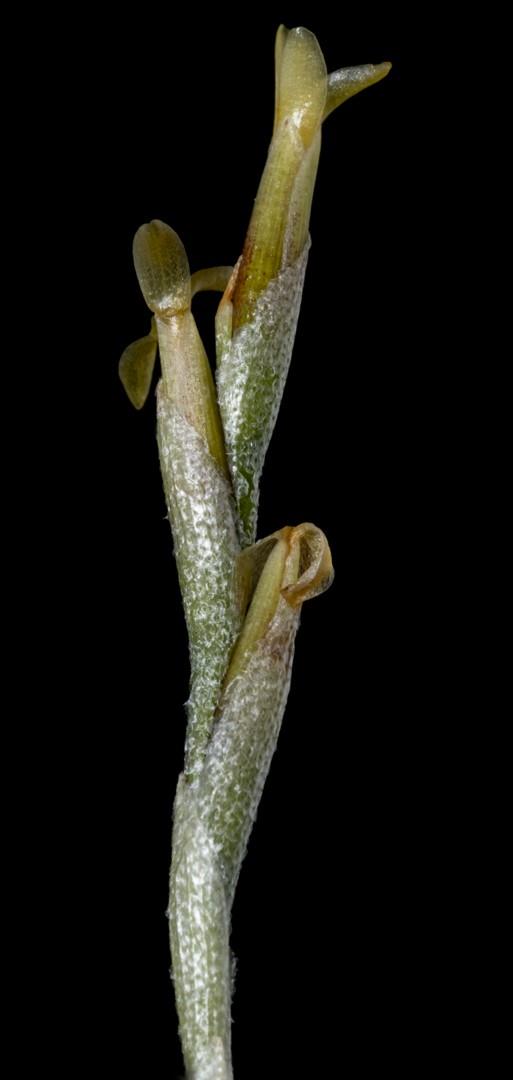
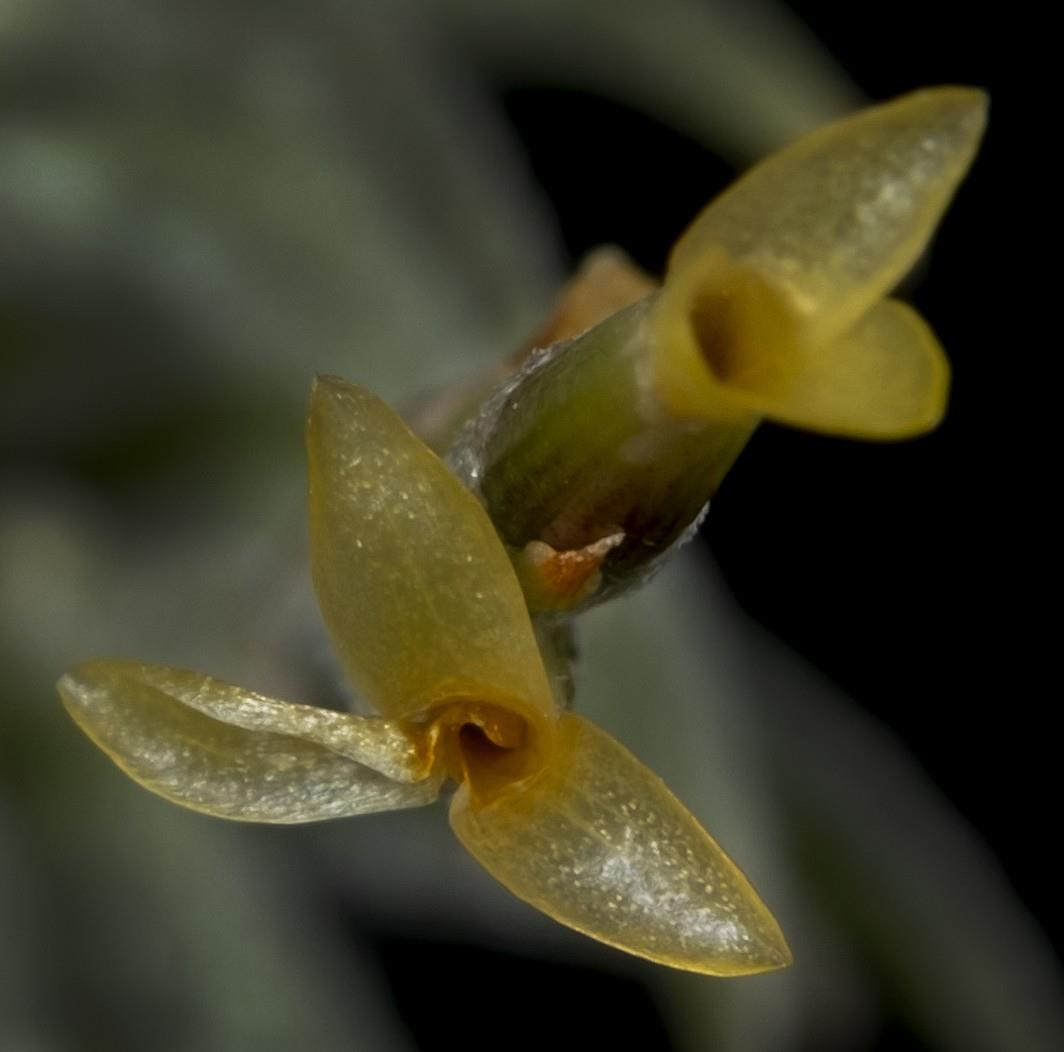
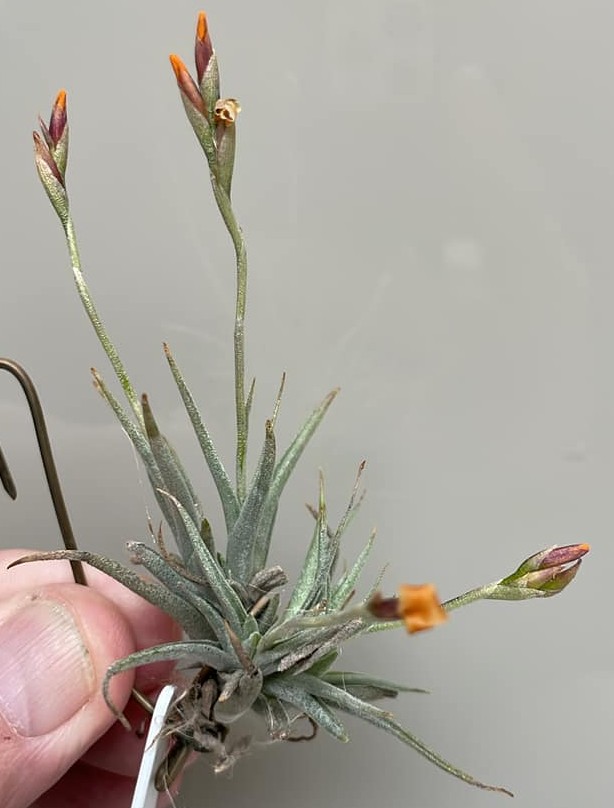
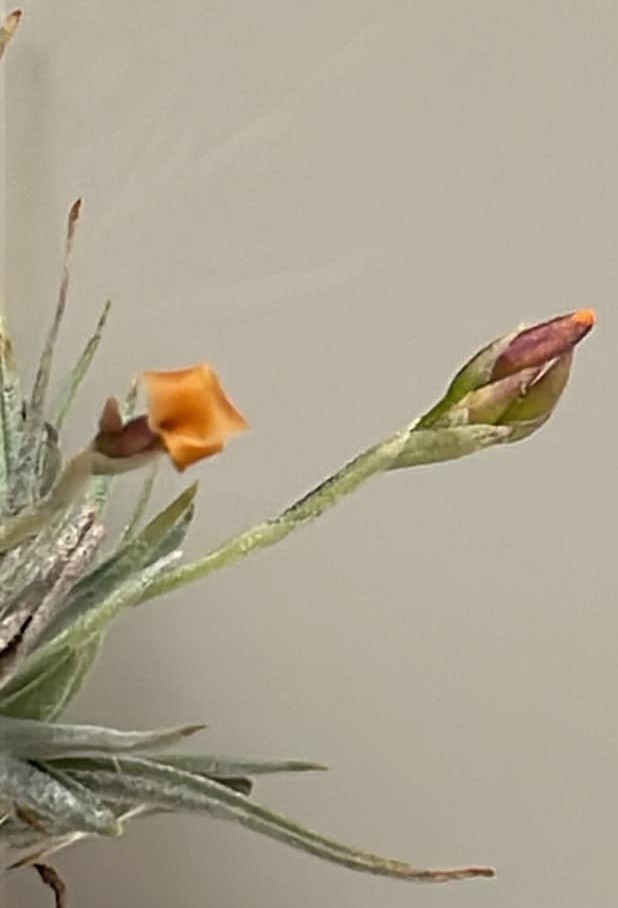
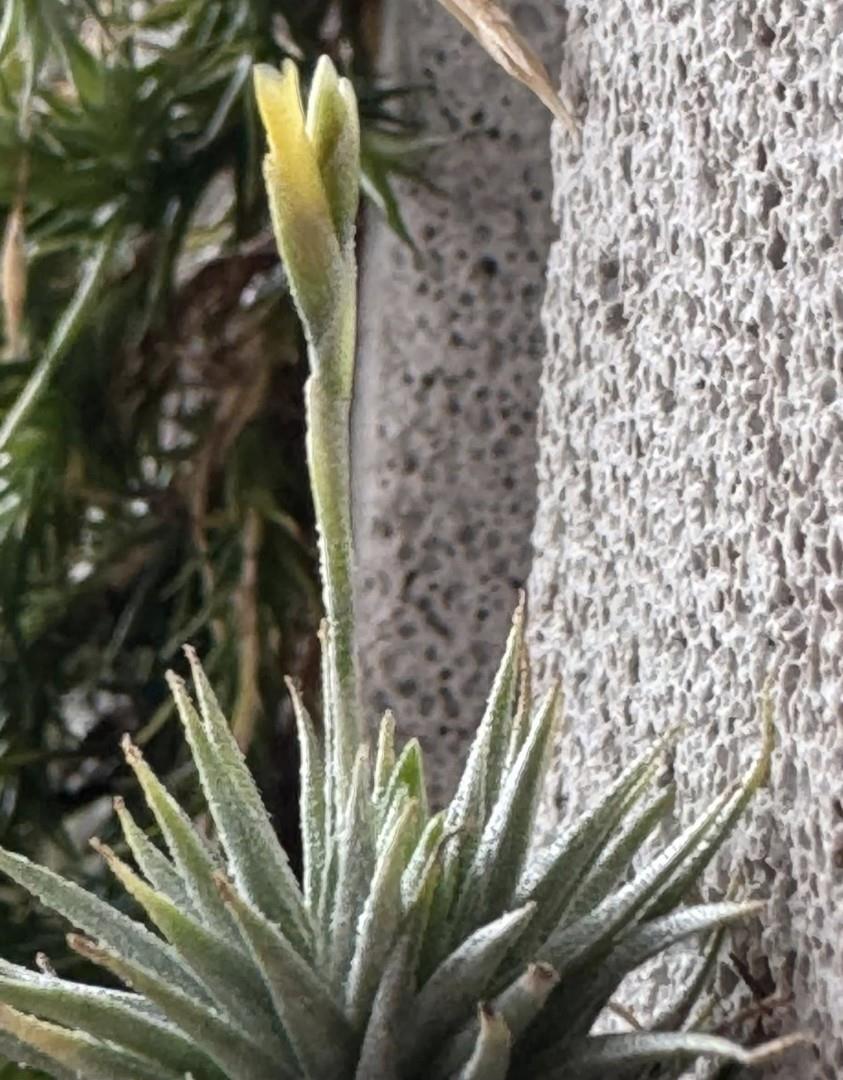
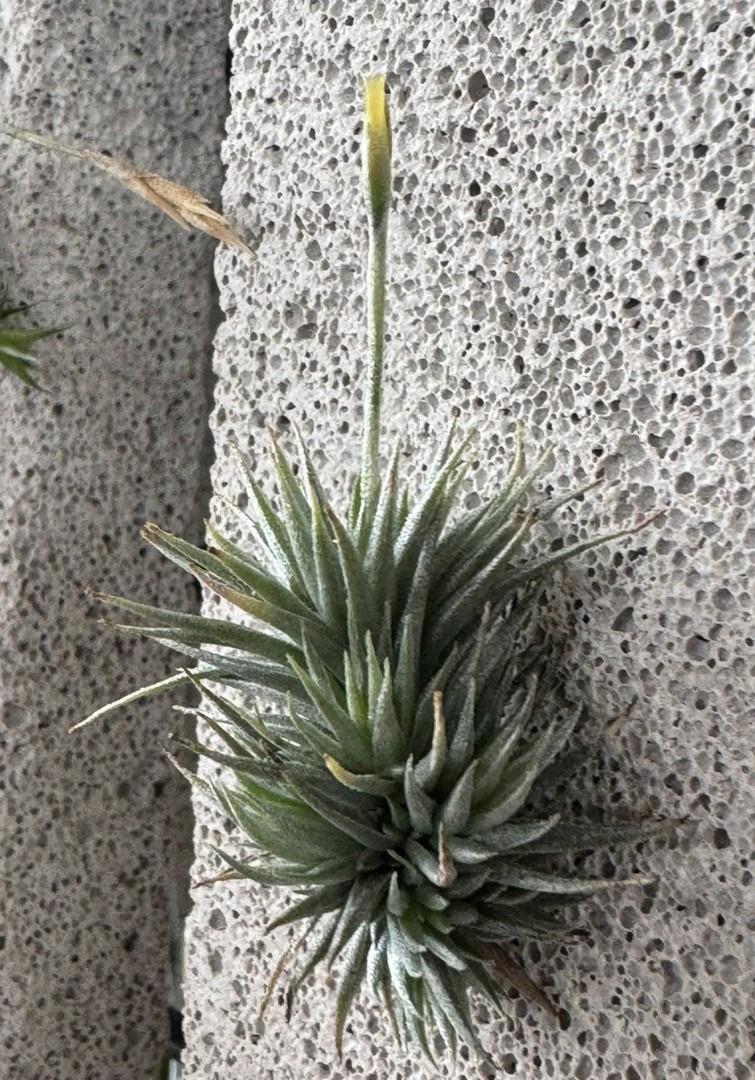
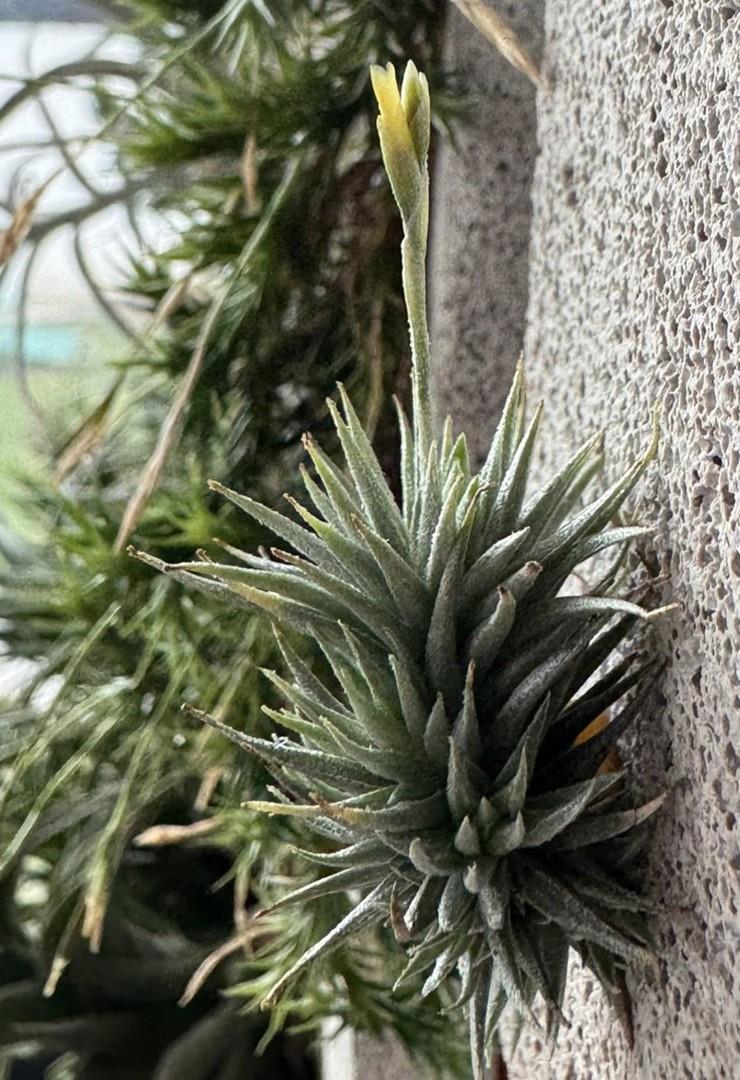
From Till 1984
Plant short stemmed or almost stemless, about 5-10 cm long, with stem-roots;
Leaves densely polystichous, mostly 20-30 mm long, dense and large scaled;
Sheath about 3 mm wide, a little wider that the blade, glabrous, almost leathery, with wide hyaline edges, nerved;
Blade very narrow triangular, robust, acuminate, not filiform, 3-5 mm wide,
Peduncle terminal, erect or bent over, to 10 cm long, to 1mm Ø, scaled.
Peduncle bracts numerous, almost as long as the internodes, elliptic, nerved, densely scaled.
Inflorescence simple, distichous, very seldom a little branched 3-8 (-16) flowered, rhachis flattened, mostly clearly geniculate, scaled
Flower bracts not imbricate, about 1.5 times as long as the internodes, ovate, tipped, scaled, (9-) 11-13 (-15) nerved, (6.5-) 7 (-10) mm long, (3.3-) 4.5 ( -5.5) mm wide,
Sepals glabrous, seldom with tip scaled, ovate-lanceolate, broad tipped, (6-) 7 (-9) – nerved, (6.5) 7 (-8) mm long, (2.2) 2.5 (-2.8) mm wide, equally almost free.
Petals tongue shaped, the upper ¼ the broadest, the tip rounded, with raphides, yellow to orange-yellow, (6-) 7- nerved, (9-) 9.5 (-10) mm long, (1.5-) 2 (2.5) mm wide
Anthers (1.2) 1.5 (-1.8) mm long, and 0.2 – 0.3 mm wide, Filaments basifixed, whitish, 1- nerved, slender, 0.1 -0.15 mm wide, (2.4) 2.8 (-3.1) mm long,
Ovary inverted conical – cylindric, style abruptly twisted together; Style rounded, about 1/3 as wide as the ovary, about ½ as long as the ovary, lobes flat, capitate;
Gynoeceum (2.5-) 3 (-3.5) mm long.
Habitat: North Peru, Central –, South- and east Bolivia, NW and NE Argentina, Central and South Paraguay, Mid to NE Brazil.
Desc from S&D p874-6
Plants to 17 cm long but usually much less; roots present; stem usually evident, simple or branched, rarely more than 4 cm long.
Leaves densely polystichous, to 4 cm but mostly 2-3 cm long, cinereous to fuscous, densely and coarsely pruinose-lepidote;
Sheaths ca 3 mm long, but slightly broader than the blade, glabrous, pale, subcoriaceous with broad hyaline margins, nerved;
Blades erect to suberect or arching-secund, rigid, very narrowly triangular, long-attenuate but not filiform, 3-5 mm wide.
Scape terminal, straight or curved, to 10 cm long, less than 1 mm in diameter, lepidote;
Scape-bracts numerous, about equaling the internodes, elliptic, acute, chartaceous, nerved, densely lepidote.
Inflorescence simple and distichous or very rarely forked, linear, to 4 cm long, very much like that of Lolium in size and sinuous outline, to 16-flowered, but often with very few;
Rhachis strongly geniculate, flattened and excavated next the flowers, lepidote.
Floral bracts not at all imbricate, about one and a half times as long as the internodes, closely enfolding the flowers, ovate, acute, 8 mm long, equaling or shorter than the sepals, ecarinate, thin, nerved, densely lepidote;
Flowers erect and appressed to the rhachis, subsessile.
Sepals lanceolate, acute, to 9 mm long, glabrous, nerved, equally short-connate;
Petals 10 mm long, pale violet (! Mez) to yellow, claw sublinear, blade narrow, acute;
Stamens deeply included, exceeding the pistil; anthers 1.25 mm long;
Ovary short-cylindric, abruptly contracted into the thick style.
Capsule slenderly cylindric, short-beaked, to 45 mm long.
Type. Martius s n (holotype M, GH photo), Monte Santo, oazeiro, Bahia, Brazil, 1818.
DISTRIBUTION. Saxicolous and epiphytic in semi-arid habitats, low levels to over 1500 m alt, Bolivia, Brazil, Paraguay, Argentina.
BOLIVIA. SANTA CRUZ, Chiquitos: San Jose de Chiquitos, 14 Sep 1942, Cutler 7083 (GH); Oriente: Charagua, Apr 1934, Cardenas 2681 (GH); Velasco: Jul 1892, Kuntze s n (NY). TARIJA: Caingua, Villa Montes, Krapovickos et a1 19437-A (US). BRAZIL. PIAUf: Guaribas, Luetzelburg s n (! Mez, probably lost at B); Colonia, Luetzelburg s n (! Mez); Manga, Luetzelburg s n (1 Mez). CEARA: Cariri, 14 Oct 1910, Loefgren 496 (R); Caninde, 21 Sep 1945, Cutler 8430 (US); Lagoa do Dentro, Chapada do Araripe, 26 Jul 1964, Castellanos & Duarte 544 (HB, US). PARAIBA: Campina Grande, Jul 1934, Wright in Con. T. P. N. B. 4338 (GH); without exact locality. 28 Jun 1959. Moraes 2184 (US). PERNAMBUCO: Caruaru (Carapotos), 18 Noy 1936, Pickel 4251 (IPA); Ibimirim, 12 Sep 1954, Falcao Egler & Pereira 1048 (IPA); Arcoyerde, 16 Ju1 1955, Lima 55-2094 (IPA). BAHIA: Calderao, Oct 1906, Ule 7002-B (HBG, L); Itumirim, 1922, Campos Porto s n (RB); Jacobina, 15 Jun 1939, Foster 95 (GH, R). MINAS GERAIS: Conselheiro Matta-Rodeador, Jun 1934, Brade s n (RB); Sete Lagoas, 18 Sep 1969, Silva 390 (US); without exact locality, Glaziou 13241 (P). DISTRITO FEDERAL: Fercal, Brasilia, 16 Apr 1961, Heringer 8186/30 (US); 5 Mar 1965, L. B. Smith 15023 (US). MATO GROSSO: Diamantino, 12 May 1894, Lindman no. B (S); Corumba, 22 Dec 1902, Robert in Sladen 791 (BM); Jul 1911, Hoehne in Rondon 3556 (R);3559 (R). SAO PAULO: Descalyado, 19 Aug 1932, A. Gehrt s n (SP); 1939, Foster 500 (GH); Itu, Sep 1967, Friedrich s n (US). PARAGUAY. Asuncion, May 1874, Balansa 619-A (BR, GOET, P, S); northern Paraguay, Sep 1892, Kuntze s n (NY); El Chaco, Rio Pilcomayo, 1893, Lindman no. A (S); Itapitapunta, Asuncion, 31 Jul 1893, Lindman A-1611-A (S); Paraguari, Aug 1893, Lindman A-1611-B (S); Concepcion, Hassler 7434 (BM, G); San Bernardino, 1914, Chodat 102-A (G); 25 Aug 1915, Osten 8106 (GH, MVM, S); 1916, 8922-B (MVM); 8920 (MVM); Primayera, 1958, Woolston 924 (US); Tebicuary, 1967, Schinini s n (HB). ARGENTINA. JUJUY: Quinta, Laguna de la Brea, 20 Jun 1901, Fries 207 (S); 24 Ju11901, 415 (S); Santa Clara, 29 Aug 1901, Fries 497 (S); Moralitos, 12 Jul 1922, Castellanos s n (BA, SI); Jujuy, 25 Sep 1938, Eyerdam & Beetle 22190-A (GH); El Quemado to Chalican, Jujuy to Urendel, 24 Oct 1948, L. B. Smith 4680 (US); Humbert 21154 (P); Skottsberg s n (GB); San Pedro to Santa Clara, 18 May 1962, Cabrera et al 14621 (LP). SALTA: Puerta de Diaz, Sep 1912, Devoto s n (BAB); Embarcacion to Yacuiba, Feb 1923, Haunwn s n (BA); Abra Grande, 17 Noy 1927, Venturi 5620 (LIL); Tabacal, 20 Ju11928, Burkart 28/707 (BA); Rio Pescado, 23 Jun 1944, Schulz & Varela 5042 (LIL); 6 Jull944, Diaz s n (LIL); San Gregorio, 26Jun 1944, Willink 3 (LIL); Cufia Muerta, s d, Schulz & Varela 5320 (LIL); SanJorge, Tartagal, 22 Ju11944, Schulz & Varela 5334 (LIL). SANTIAGO DEL ESTERO: Moreno, 24 Sep 1947, Weisburd s n (LIL). FORMOSA: Guayculee, Jun 1919, Jorgensen3396 (BA, GH, LIL, MO, SI, US); Ing. Guillermo Juarez, 21 Feb 1951, Castiglioni & Ragonese 7904 (BAB). CHACO: Colonia Benitez, Feb 1935, Schulz 808 (GH); Fontana, Sep 1938, Meyer 3065 (LIL); Rio Negro, s d, Meyer 8607 (LIL). CORDOBA: without exact locality, Mar 1925, Lossen 251 (F, GH, M, MO). CORRIENTES: San Cosme, Meyer 8845 (LIL); Paso Patria, Wurth s n (LIL); Empedrado, 9 Jun 1956, Pedersen 3925 (C, US). MISIONES: without exact locality, Niederlein s n (! Mez).
Castellanos (Gen. & Sp. Pl. Argent. 3: 308. 1945) gives Uruguay for this species but cites no specimen and none has been found.
Protologue
Tillandsia undulata Baker, Jour. Bot. London 16: 240. 1887
14. T. undulata, Baker, n. sp. Leafy stems caespitose, short, ½ - ¾ in. long, all simple. Leaves 12 - 20 to a stem, ascending, crowded, ¾ - 1 in. long, subterete, from a clasping lanceolate base, not hair-tipped, densely clothed all over with minute spreading chaffy scales. Peduncle 2-3 in. long, bearing 3-4 lanceolate striated clasping bracts. Spike laxly 3-6-flowered.; rachis very flexuose; bracts 1/4 in. long, lanceolate, tightly clasping the calyx, thinly lepidote. Calyx ¼ in., naked; sepals lanceolate. Capsule glabrous, cylindrical, 1 – 1 ¼ in. long ; valves ½ line broad.
Paraguay, at the mouth of the Rio Spane, near Villa Conception, Balansa, 619!
Calyx and capsule of T. recurvata, from which it differs by its short leaves, numerous flowers, and remarkably zigzag spike- rachis.
Detail from Baker 1889
16. T. UNDULATA Baker in Journ. Bot. 1878, 210
Leafy stems tufted, simple, an inch long. Leaves terete from a clasping base, 1-1½ in. long, ½ lin. diam. low down, tapering to a slender point, rigid in texture, densely laxly lepidote all over. Peduncle 1-3 in. long, with 3-4 small clasping bract-leaves. Flowers 1-6 in a lax spike with a flexuose rachis, sometimes 1-1½ in. long ; flower bracts oblong-lanceolate, thinly lepidote, ¼ in. long. Sepals a little longer than the bract. Capsule cylindrical, 1-1¼ in. long.
Hab. Paraguay, Balansa 619! South Brazil, Glaziou 13241! Very distinct by its many flowers and flexuose rachis.
Protologue
18.Tillandsia quadriflora Baker, Handb. Bromel. 163. 1889. Type. Ayopaya, Cochabamba, Bolivia, Weddell (4175) (P).
Leaves densely tufted, subulate from a clasping base, 1-1½ in. long, densely lepidote. Peduncle slender, 2-3 in. long. Flowers 3-4 in a distichous spike; flower bracts oblong, lepidote, ? in. long. Sepals oblong, naked, as long as the bract. Petal-blade lilac, cuneate, 1/8 in. long. Capsule an inch long.
Hab. High Andes of Bolivia, Weddell ! Mandon 1176! Banda Oriental, Miers 1363! Connects Diaphoranthema and Phytarhiza.